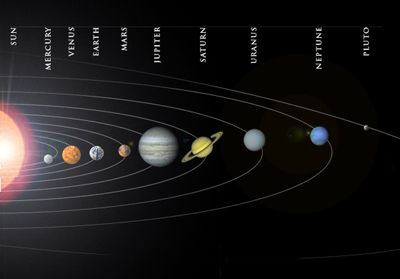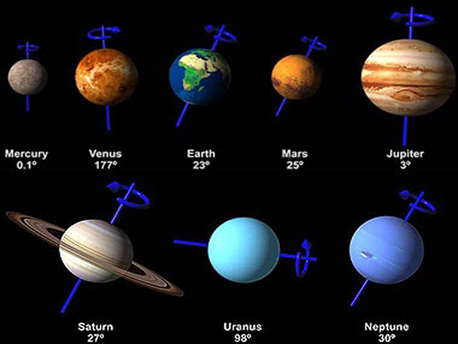Explain How the Earth Rotation Is Different From Venus
Earth has a moon Venus does not. The planet rotates counterclockwise opposite Earth and most other planets and does so exceedingly slow - one day on Venus equals 243 Earth days.

How Fast Does Venus Rotate Universe Today
Earth orbits the sun once a year and rotates on its axis once a day.

. Their atmospheres Mars and Venus is dominated by CO2 while Earths is dominated by nitrogen and has a significant amount of oxygen. The direction of the Earths rotation takes place in a counter-clockwise motion. The Earth spins on its axis at a faster speed as compared to the planet Venus making the latter experience longer days.
Not a major difference but a. The speed on how these two planets rotate also differs. For differences students may say that Venus us hotter and Earth is cooler.
Imagine getting sunlight after so long. Venus and Earth are planets in our solar system with Venus being the second closest planet and the Earth being the third closest to the sun. Therefore while one Cytherean or Venusian year takes around 224701 earth days Venus experiences two or less complete sunrises and sunset in that period.
Our neighboring planet Venus is an oddball in many ways. The Earth takes a full year 365 days for one complete revolution around the Sun. This means that Earths revolution takes place from the West to the East.
The Earth takes 24 hours to complete a rotation with respect to the sun. All planets rotate on an axis but they do it at different speeds. But some planet takes more time.
Venus the second closest planet to the Sun is different from all the other rocky planets in our Solar System in that its orbit and rotation is different from the others. Instead Earth has seasons because our planets axis of rotation is tilted at an angle of 235 degrees relative to our orbital plane that is the plane of Earths orbit around the sun. Pluto is no longer classed as a planet but if it did Venus would still be different to it.
For starters it spins in the opposite direction from most other planets including Earth. However that is not the case. It has a synodic day length of 117 Earth days and a sidereal rotation period of 243 Earth days.
Earths rotation period is 23hours 56minutes4 seconds. Because a rotation is the same as a day a day on Venus lasts for eight months. I am too bored to explain with diagrams but lets try Imagine the Earth as the lamb and the Sun as the ashes below the lamb.
Other planets have different time periods Mercury 1407 hours Venus 5832 hours Earth 239 hours Mars 246 hours Jupiter 99 hours Saturn 107 hours Uranus 172 hours Neptune 161 hours. In science we call that rotating on its axis. Jupiter on the other hand rotates quite fast.
Venus rotates very slowly on its axis one day on Venus lasts 243 Earth days. It takes eight months for Venus to spin one time on its axis. The mass of the earth is about 123 times the mass of Venus.
Earth rotates counter-clockwise and Venus rotates clockwise. The morning star Venus takes the longest time of 243 days to complete one rotation. Rotation of the Earth is its turning on its axis.
The Earths orbit makes a circle around the sun. Venus is also different from Earth in having a much lower level of erosion because no precipitation and surface wind speeds are very low. Revolution is the movement of the Earth around the Sun.
The major way that their surfaces undergo large-scale changes plate. The presence or absence of liquid water on their surfaces today. Venus has a very slow rotation.
The Earths axis of rotation is tilted by 235 degrees. The geology of Earth is dominated by plate tectonics Venus has blob tectonics where the rising of hot material from within plays a dominant role in sculpting its surface. Since the Earth orbits the sun AND rotates on its axis at the same time we experience seasons day and night and.
Venus is the most similar planet to the Earth in terms of size but. Consequently it takes longer to rotate about its axis than any other planet in the Solar System and does so in the opposite direction to all but Uranus. It feels as if the sun is moving and is then being replaced by the moon.
Earths rotation period relative to the precessing or moving mean vernal equinox meanwhile is 23 hours 56 minutes and 40905 seconds of mean solar time. Uranus also has this peculiarity but Uranus is a gas giant. Looking at the photo above you might have seen a.
The Earth is as precious as every life on Earth is. While the average temperature on the earth is about 14 C that on Venus is over 460 C. However similar to mercury its slow rotation and speed make a single solar day the time the sun requires getting to the same position in the sky which lasts around 117 days.
Still another difference between the planet Earth and the planet Venus is that Venus does not have any moons that revolve around the planet. Venus orbits the Sun every 2247 Earth days. Their size Mars is significantly smaller.
The three planets are different in many ways among them. At the same time the Earth orbits around the sun it also spins. Being closer to the sun Venus is a lot hotter than the Earth.
Venus probably does not have water and Earth has water. The planet orbits the Sun faster than Earth however so one year on Venus takes only about 225 Earth days making a Venusian day longer than its year. One rotational spin of the Earth brings about day and night.
One rotation is fewer than 10. The orbital period of Venus is 225 days so that a Venus year takes less than a full. The ashes are hot they emit energy and the lamb absorbs that energy and gets cooked.
The Earth moves in two different ways. Earths Rotation you are correct. Somebody has said that we have.
Whereas Earth rotates in about 24 hours Venus rotates in the contrary sense retrograde rotation in 243 days. The time taken by Earth for rotation is ideal as in 24 hours the whole planet receives sunlight more or less.


No comments for "Explain How the Earth Rotation Is Different From Venus"
Post a Comment